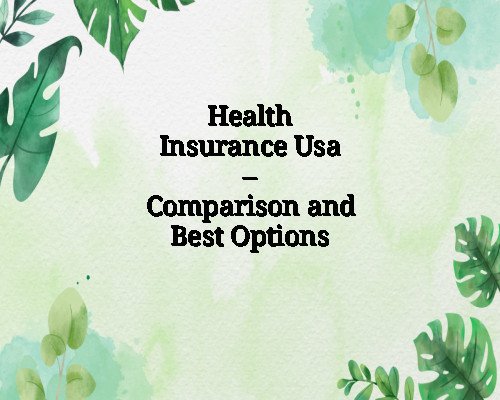Health Insurance in the USA: Comparison and Best Options
Health insurance in the United States can be complex and overwhelming, with various plans and options to consider. Navigating through the many types of health insurance is crucial to finding a plan that meets your needs and fits your budget. This guide will provide a comprehensive comparison of the different types of health insurance in the USA, helping you identify the best options for you and your family.
Understanding Health Insurance in the USA
Health insurance is a system where individuals or groups pay premiums to an insurance provider in exchange for coverage of medical expenses. The purpose of health insurance is to protect individuals from the high costs of healthcare by covering a portion of the expenses related to medical services, treatments, and prescriptions.
The U.S. health insurance system is unique because it is a mix of private and public options, and the costs and coverage vary widely between different plans. Understanding the types of insurance available and their differences is the first step toward making an informed decision.
Types of Health Insurance Plans in the USA
There are several types of health insurance plans available in the USA, each with its own set of features, benefits, and costs. The main categories of health insurance are:
1. Employer-Sponsored Health Insurance
Employer-sponsored health insurance is a common option for employees working in the private or public sectors. Employers typically offer health insurance plans to their employees, and many also contribute a portion of the premium costs. This is often the most affordable option for employees, as employers usually negotiate group rates and may provide subsidies for the premiums.
Pros:
-
Lower premiums due to employer contributions.
-
Easy enrollment process, as the employer handles much of the paperwork.
-
Access to group plans with more affordable rates.
Cons:
-
Limited to the plans offered by the employer.
-
If you change jobs, you may lose your coverage or have to switch plans.
-
Not available to self-employed individuals.
2. Health Insurance Marketplace (ACA Plans)
The Affordable Care Act (ACA) created a government-run marketplace where individuals and families can purchase health insurance plans. These plans are available through HealthCare.gov or state-run exchanges and are designed to provide comprehensive coverage for people who are self-employed, unemployed, or do not have employer-sponsored coverage. Depending on your income, you may qualify for subsidies to help lower the cost of premiums.
Pros:
-
Variety of plans and coverage options.
-
Subsidies available for those who qualify based on income.
-
Guaranteed coverage for individuals with pre-existing conditions.
Cons:
-
Premiums can be higher than employer-sponsored plans if you do not qualify for subsidies.
-
Limited enrollment periods; you must apply during open enrollment unless you qualify for special circumstances.
3. Medicaid
Medicaid is a government program that provides health insurance to low-income individuals and families, including pregnant women, children, the elderly, and people with disabilities. Medicaid is jointly funded by the federal government and individual states, so eligibility and coverage can vary depending on where you live.
Pros:
-
Low to no cost for coverage.
-
Provides comprehensive coverage, including doctor visits, hospital stays, prescriptions, and more.
-
Available for individuals with specific income thresholds.
Cons:
-
Eligibility requirements vary by state.
-
Coverage may not be as comprehensive in some states.
-
Limited provider options in some regions.
4. Medicare
Medicare is a federal program designed for individuals aged 65 and older, or for younger people with disabilities. It is divided into parts: Part A (hospital insurance), Part B (medical insurance), Part C (Medicare Advantage), and Part D (prescription drug coverage). While Medicare provides significant coverage, it does not cover all medical expenses, and there may still be gaps in coverage that need supplemental insurance.
Pros:
-
Comprehensive coverage for seniors and those with disabilities.
-
Federal program, so it’s available nationwide.
-
Can be combined with private insurance to cover additional costs.
Cons:
-
Does not cover everything; you may need supplemental insurance.
-
Premiums, deductibles, and copayments can add up.
-
No coverage for long-term care.
5. Short-Term Health Insurance
Short-term health insurance plans provide temporary coverage for people in between major medical plans, such as during job transitions or waiting for ACA open enrollment. These plans are typically less expensive than traditional plans but offer limited coverage and fewer benefits.
Pros:
-
Lower premiums compared to other types of insurance.
-
Flexible options for temporary coverage.
Cons:
-
Limited coverage, often excluding essential health benefits like maternity care and mental health services.
-
Can reject applicants with pre-existing conditions.
-
Not suitable for long-term healthcare needs.
6. Catastrophic Health Insurance
Catastrophic health insurance is designed to cover worst-case scenarios, such as major accidents or severe illnesses. This plan typically has low monthly premiums but high deductibles and is intended for young, healthy individuals or those who cannot afford traditional insurance. It is available to people under 30 or those with exemptions.
Pros:
-
Very low premiums.
-
Coverage for emergencies and serious health conditions.
Cons:
-
High deductibles and out-of-pocket costs before coverage kicks in.
-
Does not cover most routine medical services or preventive care.
How to Choose the Best Health Insurance Plan
When deciding on the best health insurance plan, several factors need to be considered to ensure it meets both your healthcare and financial needs:
1. Assess Your Healthcare Needs
Consider your medical history and current health. If you have chronic conditions, regular doctor visits, or need prescription medications, you may want to select a plan that offers comprehensive coverage and includes your providers in the network.
2. Compare Premiums and Deductibles
Premiums are the monthly payments you make for health insurance, while deductibles are the amount you pay out-of-pocket before your insurance starts to pay. Finding a balance between premiums and deductibles is key. A plan with lower premiums may have higher deductibles, and vice versa.
3. Understand the Network
Health insurance plans often have networks of doctors, hospitals, and clinics that they work with. Some plans offer wider networks, while others may have limited provider options. If you have preferred doctors or specialists, make sure they are included in the network of the plan you choose.
4. Look for Additional Benefits
Some health insurance plans offer additional benefits like dental, vision, or mental health coverage. If these are important to you, look for plans that include these services, or consider a separate policy for them.
5. Check for Prescription Drug Coverage
If you take medications regularly, make sure the health insurance plan includes prescription drug coverage. Some plans have formularies (lists of covered drugs), so check if your medications are included before making a decision.
Popular Health Insurance Providers in the USA
Several major insurance providers offer health plans in the USA. The most well-known providers include:
-
UnitedHealthcare: Offers a variety of plans, including individual, family, and employer-based options. Known for a wide network and comprehensive coverage.
-
Blue Cross Blue Shield: One of the largest providers in the U.S., offering a range of plans through various state-specific entities.
-
Cigna: Known for its customer service and global coverage, Cigna offers individual, family, and group health plans.
-
Aetna: Aetna provides both individual and employer-sponsored plans, with a focus on preventative care and wellness programs.
-
Humana: Focuses on individual and family plans, and is especially popular for Medicare Advantage plans.
Conclusion: Which Health Insurance Plan is Right for You?
Choosing the right health insurance plan depends on various factors, including your age, health status, income, and personal preferences. For many people, employer-sponsored insurance provides the most affordable option, while others may prefer government programs like Medicaid or the ACA marketplace for more flexibility. Short-term and catastrophic plans are suitable for those in temporary situations or those who are young and healthy.
By carefully evaluating your needs and comparing available options, you can find the best health insurance plan to protect yourself and your family against high medical costs.

